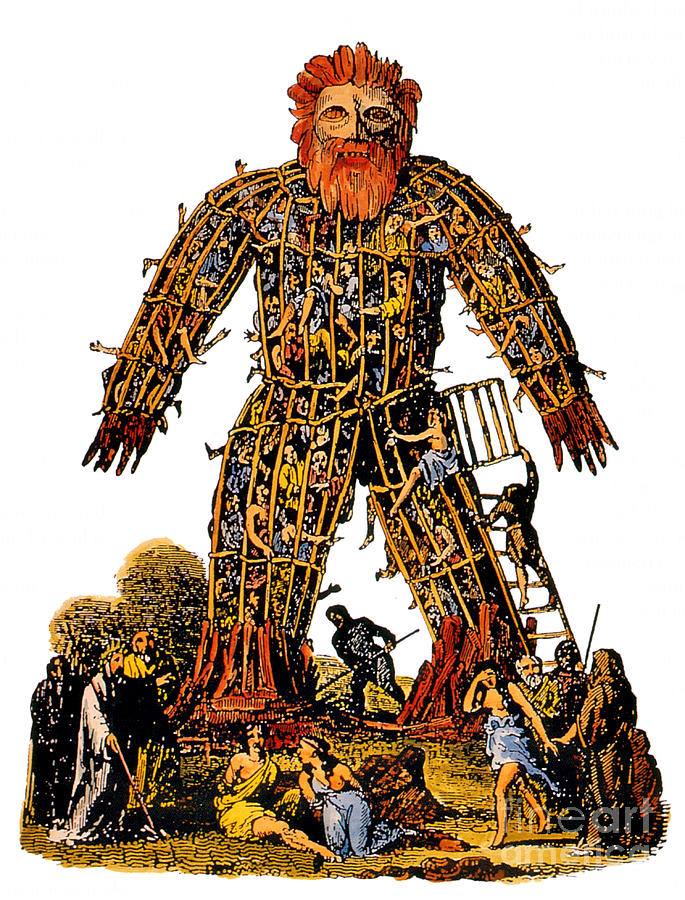

The Dark Past Of Halloween and Alternative Celebration Ideas ...by Doctor Know
The Halloween celebrated today was born from the Celtic New Year and Harvest Feast of Samhain. Samhain was established by the powerful Druid Priests who were responsible for the spiritual well being of the Celts. Druids were an upper class of priests and professionals that acted as judges, administrators and advisers. The Druids passed their history and practices down verbally, so we don't know when Samhain began. The Celts became an organized society around 1200 BC. It is likely that this festival was first observed within a few hundred years of that date. What we do know about Druids comes from the Romans and Europeans that studied and wrote about them.
Samhain was an annual event which began on the evening of October 31st and ended on the evening of November 1st. For unknown reasons a Celtic day was measured from one evening to the next. Druid Priests believed that during Samhain the unseen separations between this world and the next were taken down allowing spirit beings and the dead to cross over both ways. To appease their gods and keep the dead from lingering or doing harm to the living they performed rituals that even managed to shock the brutal Roman Army when they arrived in 55 BC.

During Samhain Celts danced around bonfires which were lit, extinguished and relit to mark the passing of the old year and celebrate the new year. Meanwhile, the Druid Priests prepared living sacrifices. The huge form of a man was built out of tree branches. It was later stuffed with criminals, innocent children and some random adults, then set on fire. The Priests went out on Samhain Eve and knocked on doors. They asked parents to give them young children or virgins for sacrifice if there were not enough criminals to fill their structure. They also collected food and homemade candy to feed to those who would be burned.
Those who gave them a child or provisions were given a carved out pumpkin with a lighted candle made from human fat inside. That was placed in front of their house as a sign that they had made a contribution. Those who refused to give the Druid Priests a child, virgin or food were later punished by roving groups of men looking for homes without lighted pumpkins. The men would damage their property and beat them. Sometimes a symbol was painted on the door of people who not only failed to give, but opposed the Druids. That symbol marked that family for death. If more people were needed for the burning they might be taken away for that purpose.
Recognizing the power that the Druids had and unwilling to tolerate human sacrifice, Roman Generals (including Julius Caesar) decided the only way to deal with Druid Priests was to annihilate them in Roman occupied areas. Caesar studied the Druids while he was Governor of Gaul and wrote about their influence over the Celts, as well as their religious ceremonies…
“The whole Gallic nation is virtually a prey to superstition, and this makes the serious invalids or those engaged in battle or dangerous exploits sacrifice men instead of animals. They even vow to immolate themselves, using the Druids as their ministers for this purpose. They feel that the spirit of the gods cannot be appeased unless a man's life is given for a life. Public sacrifices of the same sort are common. Another practice is to make images of enormous size, with the limbs woven from osiers [willows]. Living human beings are fitted into these, and, when they are set on fire, the men are engulfed in the flames and perish. The general feeling is that the immortal gods are better pleased with the sacrifice of those caught in theft, robbery or some other crime. But if a supply of such criminals is lacking, then they resort to the sacrifice of completely innocent victims. . . " - Julius Caesar (written 51 to 59 AD)
Human Sacrifice was illegal in the Roman Empire. After the Roman Emperor Claudius outlawed the Druids in 54 AD, a large number of Roman Soldiers were sent to the island of Anglesey by the Roman Governor of Britain in 60 AD. Anglesey was the spiritual homeland of Druid beliefs and large numbers of them gathered there on a regular basis. The Romans laid waste to the worship center and killed all the Druids they could find. After that, Druids throughout Europe, England and Ireland either went into hiding or ceased all human sacrifices.
Despite its once horrific sacrificial ceremonies, the harvest feast of Samhain had been so popular for so long that when Christianity spread throughout areas once dominated by Druids, the Christians established their own version of a harvest feast to commemorate the martyrdom of the saints as an alternative. The hope was that it would lure pagans to Christianity and discourage Christians from falling back into pagan feasts and ceremonies.
After several centuries the Christian harvest festival was embraced by the Catholics. Pope Gregory III moved All Saints Day to November 1st which made October 31st All Hallows Eve and a key part of the festival celebration. Some aspects of the pagan feast were passed on to the Christian Feast on All Hallows Eve and remain today in secular Halloween celebrations. These include carved out and lighted pumpkins, trick or treat and people in costumes to recall when spirits traveled freely between worlds.
After immigrants from Ireland, Scotland and parts of England brought the secular version of Halloween to America in the late 1800s, many Christians and Churches had problems with some of the occult symbols and malevolent themes used in the celebration. They disliked children dressing up as witches, vampires, monsters and fiends. Churches and Communities where Halloween activities were not welcome began offering alternatives. By the 1940s Harvest Festivals, Fall Carnivals and Fall Block Parties with games and goodies were popular among Christians and Churches that rejected Halloween. These alternatives continue today.
Many Churches in America have special events planned for October 31st. Most are built around the Fall Harvest and include something for all ages. Activities like bobbing for apples, stomping on balloons made to look like pumpkins, having children dress up in costumes so they look like Bible Characters and creating a carnival atmosphere with a Midway and Activity Booths are popular. Participation games like The Blind Surgeon are also fun.
Put various food items in bowls on a long table out of the sight of game players. Blindfold participants, then have them guess what body parts they are touching in the bowls. After several players have gone through, remove their blindfolds and see who came closest to what the item looks like. Ramen noodles with red and green food coloring can be blood vessels. Misshapen tomatoes can be made to look like hearts. It's a great chance to get creative.
Kids that come in Bible Characters costumes can give presentations about their characters making it a learning experience for all. The opportunity can also be used to collect canned foods for local food pantries. You can rent things like a dunk tank or bouncy house and make it a family fun night. Those gifted in crafting can set up tables for kids, teens and adults to make things like sock puppets. Others can teach people how to do scrapbooking or create custom decorated items such as cell phone cases.
Doctor Know (Bill) can be contacted on
FACEBOOK.
BACK to Doctor Know
©




